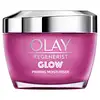What's inside
What's inside
 Key Ingredients
Key Ingredients

No key ingredients
 Benefits
Benefits

 Concerns
Concerns

No concerns
 Ingredients Side-by-side
Ingredients Side-by-side

Water
Skin ConditioningVinyl Dimethicone/Methicone Silsesquioxane Crosspolymer
Glycerin
HumectantNiacinamide
SmoothingIsohexadecane
EmollientIsopropyl Isostearate
EmollientPanthenol
Skin ConditioningPalmitoyl Pentapeptide-4
Skin ConditioningCeratonia Siliqua Fruit Extract
MaskingSodium Hyaluronate
HumectantDimethicone
EmollientCaprylyl Glycol
EmollientDimethiconol
EmollientCetearyl Glucoside
EmulsifyingCetearyl Alcohol
EmollientStearic Acid
CleansingPalmitic Acid
EmollientStearyl Alcohol
EmollientCetyl Alcohol
EmollientBehenyl Alcohol
EmollientArachidyl Alcohol
EmollientDisodium EDTA
PEG-100 Stearate
Sodium Polyacrylate Starch
Absorbent1,2-Hexanediol
Skin ConditioningPhenoxyethanol
PreservativeBenzyl Alcohol
PerfumingWater, Vinyl Dimethicone/Methicone Silsesquioxane Crosspolymer, Glycerin, Niacinamide, Isohexadecane, Isopropyl Isostearate, Panthenol, Palmitoyl Pentapeptide-4, Ceratonia Siliqua Fruit Extract, Sodium Hyaluronate, Dimethicone, Caprylyl Glycol, Dimethiconol, Cetearyl Glucoside, Cetearyl Alcohol, Stearic Acid, Palmitic Acid, Stearyl Alcohol, Cetyl Alcohol, Behenyl Alcohol, Arachidyl Alcohol, Disodium EDTA, PEG-100 Stearate, Sodium Polyacrylate Starch, 1,2-Hexanediol, Phenoxyethanol, Benzyl Alcohol
Water
Skin ConditioningPrunus Armeniaca Kernel Oil
MaskingOlea Europaea Fruit Oil
MaskingGlycerin
HumectantGlyceryl Stearate Citrate
EmollientSodium Levulinate
Skin ConditioningSodium Anisate
AntimicrobialOlea Europaea Leaf
Skin ConditioningBetaine
HumectantDaucus Carota Sativa Juice
Skin ConditioningSolanum Lycopersicum Fruit Juice
Skin ConditioningSclerotium Gum
Emulsion StabilisingGlyceryl Caprylate
EmollientDaucus Carota Sativa Root Extract
Skin ConditioningIngredients Explained
These ingredients are found in both products.
Ingredients higher up in an ingredient list are typically present in a larger amount.
Glycerin is already naturally found in your skin. It helps moisturize and protect your skin.
A study from 2016 found glycerin to be more effective as a humectant than AHAs and hyaluronic acid.
As a humectant, it helps the skin stay hydrated by pulling moisture to your skin. The low molecular weight of glycerin allows it to pull moisture into the deeper layers of your skin.
Hydrated skin improves your skin barrier; Your skin barrier helps protect against irritants and bacteria.
Glycerin has also been found to have antimicrobial and antiviral properties. Due to these properties, glycerin is often used in wound and burn treatments.
In cosmetics, glycerin is usually derived from plants such as soybean or palm. However, it can also be sourced from animals, such as tallow or animal fat.
This ingredient is organic, colorless, odorless, and non-toxic.
Glycerin is the name for this ingredient in American English. British English uses Glycerol/Glycerine.
Learn more about GlycerinWater. It's the most common cosmetic ingredient of all. You'll usually see it at the top of ingredient lists, meaning that it makes up the largest part of the product.
So why is it so popular? Water most often acts as a solvent - this means that it helps dissolve other ingredients into the formulation.
You'll also recognize water as that liquid we all need to stay alive. If you see this, drink a glass of water. Stay hydrated!
Learn more about Water